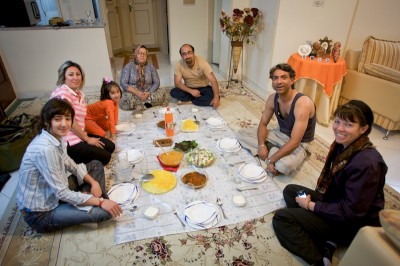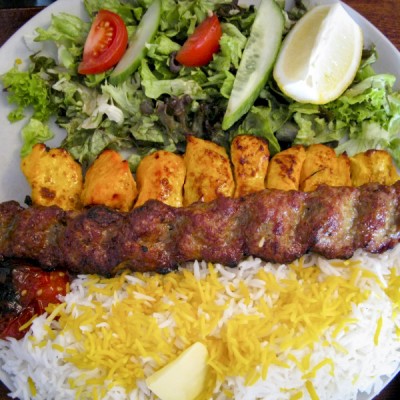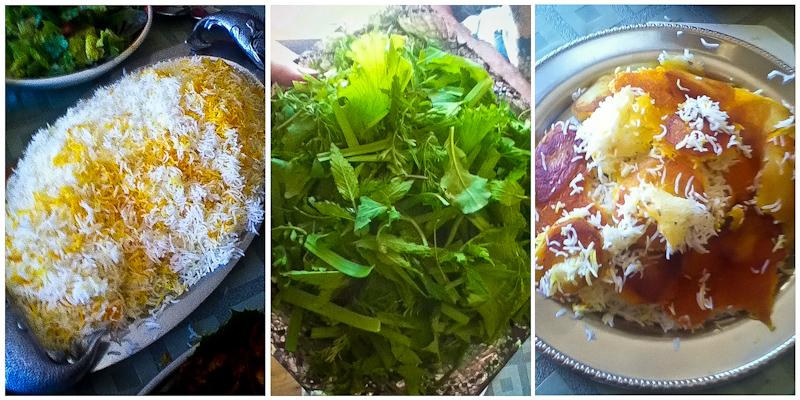Welcome to Iranian culture, where hospitality is king and food is the first step to friendship.
For almost as long as human beings have been eating, they’ve been doing it together. Congregating over food, inviting people to your home for a feast, and bringing gifts to each others’ houses are pretty much cultural universals.
But these traditions are especially prominent in my own Persian culture, where food is an excuse for getting together and a time to build personal relationships with one another.
Growing up, I saw my parents have a mehmooni (“party” in Farsi) at least once a week, inviting over our circle of Iranian friends, whose homes we were invited too regularly as well.
Each of these mehmoonis, my mom would clean the house from top to bottom, cook at least 3 different dishes (at the same time), and brew tea in the samovar (Persian tea kettle). Growing up watching how much effort Iranians put into preparing for their mehmoon (guests), I realized that our hospitality is one of our strongest cultural assets.

It didn’t matter who was coming over, stranger or not. They were going to be sitting down at the kitchen table, with assortments of nuts, fruit, and Iranian candies, while we quite literally, continuously offered them different things to eat.
Declining this offer the first time is considered to be very polite, as the guest does not want to impose on the host. But with further persistence from the host, the guest eventually tastes the offerings. This action is referred to as taa-roff, which has no English translation, but very important in Persian Culture.
Many Non-Iranians have asked me “What is Persian food like?”
The answer varies greatly: We eat all kinds of meats and fresh vegetables, in a variety of dishes with all kinds of spices.
My taste buds’ first memory of Persian food was kateh maast vah keeshmeesh (Persian for “rice, yogurt, and raisins), along with feerinee which is warm milk, startch, and a little bit of rose water, eaten as a soup.
The most popular Persian meal is chelo kabob, which is translated as “rice and meat.” The kabob can be in forms of barg (filet minion) koobideh (ground meat) or joojeh (chicken). The meat is usually marinated in onion, garlic, saffron, turmeric, and a bit of water and grilled on skewers over burning coal.
This traditional meal is usually served with grilled tomatoes, onions, sabzi (greens), with the chelo (rice) serving as the most extravagant part of the meal.

Along with this meal, it is custom to drink dough which is “yogurt water,” literally made with yogurt, water, and mint spices. This drink can be carbonated or regular and is an all-time favorite for many Iranians.
Rice is usually the centerpiece of Persian meals, and it’s really what makes Persian cooking so challenging.
As Washington Post food writer Tim Carman discovered in a blog post last year, mastering the fluffy texture of proper Persian rice “demands a sacrifice of your time, a devotion to specific practices and a willingness to wait for your reward.”
Once the rice has been soaked and drained several times and left to cook for over an hour, the bottom of the pan forms tahdiq crunchy rice.
My fondest memory of Iran is when I had visited a village and the host family had spread out a sofreh, which is when all the guests sit on the floor around a large table cloth that is covered in an array of food.
Endless plates of saffron rice, fried fish, and torshi — which is pickled vegetables that have been marinated in vinegar and garlic for years. (The longer the marination, the better the taste!)
Even though Iran is miles away, there are many ways for Seattleites to sample Persian Cuisine (other than fishing for an invitation to my mom’s house for a home cooked meal).
There are plenty of Persian spots in the Seattle area, including Pacific Market in Lake City, which includes groceries and food, Persepolis Grill in the University District, Caspian in Bellevue, and Farvahar Persian Café in Downtown Seattle. With a number of options for all different taste buds, I assure you, there is something for everyone!



1 Comment
Comments are closed.